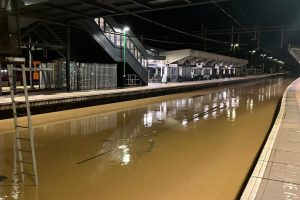Geotechnical assessments and emergency repairs on a deteriorating rock face on the A828 trunk road between Ledaig and Benderloch in Scotland were completed earlier this month.
NCE sister title Ground Engineering reported that a section of the A828 between Ledaig and Benderloch was reopened on 16 November under traffic signal control, following emergency works to make the high rock face in this location safe. The site Is located just over 3km north of Connell Bridge in Argyll and Bute.
The repairs were completed within 23 hours of the full closure of the road and adjacent foot and cycle paths at 8pm on 15 November.
Transport Scotland’s operating company Bear Scotland had partially closed the road a day earlier to allow operatives to implement measures safeguarding essential utilities beneath the road surface from potential rock debris impacts.
This was after visual inspections identified deterioration of a 25t area surrounding a fractured rock mass. The rock posed a threat of breaking away from the main slope.
Bear Scotland, on behalf of Transport Scotland, worked together with specialist rope access and rock slope stabilisation subcontractor Geo-Rope and geotechnical advisor and designer Jacobs to complete the emergency stabilisation.
In addition, aggregate bund and haulage supplier A&L McCrae, traffic management provider Markon and variable messaging boards provider Alba supported the works.
The emergency works entailed block removal and scaling of the 25t rock mass positioned approximately 60m above road level, utilising a rope access and air bag method.
“To protect multiple services and trunk road assets an aggregate bund was formed to absorb and contain the falling block,” a Bear Scotland spokesperson told GE.
Geotechnical assessments
Jacobs and Geo-Rope conducted recent rope access and drone inspections of the rock face. The visual observations were compared to records from May 2024.
“These inspections showed the condition of a block on the slope that had deteriorated since the previous visit in May 2024, with the jointing appearing to have dilated further,” the Bear Scotland spokesperson said.
“Through further visual inspection, during the course of the emergency works, it was determined that the block would be removed as it posed an immediate hazard to trunk road traffic and users of National Cycle Network 78.”
The rock type in this location is particularly susceptible to weathering, causing slope stability issues.
The spokesperson explained: “The bedrock in this area comprises conglomerate, which is made up of clasts of gravel and cobbles held in a sandy matrix.”
They added: “The rock slope in this area is characterised by intersecting joint sets, forming some isolated blocks on the rock face, which are distinct from the overall rock mass. Specific isolated blocks were considered to potentially have marginal stability as a result of continued weathering and dilation of the joints within these areas.”
Next steps
Following the completion of the emergency works, the A828 and National Cycle Network 78 reopened under traffic signal control. A small bund was left in place to manage any small-scale residual debris, which may fall from the affected area.
Bear Scotland’s north west representative Ian Stewart said: “The emergency works to remove the 25t rock mass proved successful, and we’re pleased reopen the A828 between Ledaig and Benderloch to road users, pedestrians and cyclists. Traffic signals have been retained to allow us to continue monitoring the area in question.”
Plans for a wider rock face stabilisation project in the area are currently under discussion between Transport Scotland, Bear Scotland and Jacobs.
Bear Scotland, comprised of Vinci, Jacobs and Breedon, is responsible for 60% of Scotland’s trunk road network, including the North West Trunk Road Unit. The unit covers 1,422km of trunk road and 1,501 bridges and structures. As part of trunk roads within this unit, the A828 runs from the Ballachulish Roundabout on the A82 to Connel on the A85.
Like what you've read? To receive New Civil Engineer's daily and weekly newsletters click here.
 New Civil Engineer Civil engineering and construction news and jobs from New Civil Engineer
New Civil Engineer Civil engineering and construction news and jobs from New Civil Engineer




Have your say
or a new account to join the discussion.